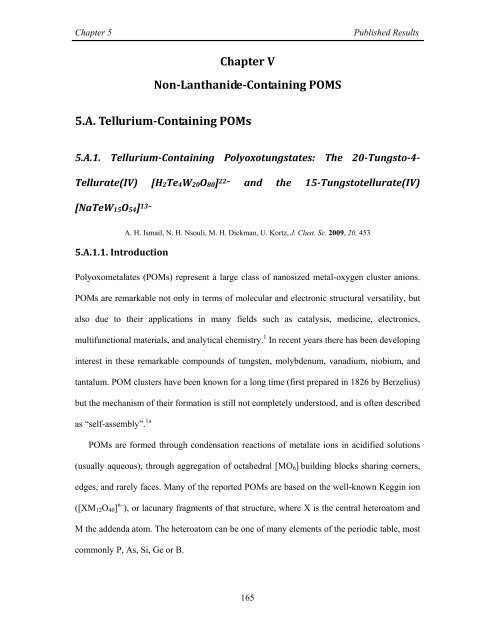Synthesis and Structural Characterization of ... - Jacobs University
Synthesis and Structural Characterization of ... - Jacobs University
Synthesis and Structural Characterization of ... - Jacobs University
Create successful ePaper yourself
Turn your PDF publications into a flip-book with our unique Google optimized e-Paper software.
Chapter 5<br />
Published Results<br />
Chapter V<br />
Non‐Lanthanide‐Containing POMS<br />
5.A. Tellurium‐Containing POMs<br />
5.A.1. Tellurium‐Containing Polyoxotungstates: The 20‐Tungsto‐4‐<br />
Tellurate(IV) [H2Te4W20O80] 22− <strong>and</strong> the 15‐Tungstotellurate(IV)<br />
[NaTeW15O54] 13−<br />
A. H. Ismail, N. H. Nsouli, M. H. Dickman, U. Kortz, J. Clust. Sc. 2009, 20, 453<br />
5.A.1.1. Introduction<br />
Polyoxometalates (POMs) represent a large class <strong>of</strong> nanosized metal-oxygen cluster anions.<br />
POMs are remarkable not only in terms <strong>of</strong> molecular <strong>and</strong> electronic structural versatility, but<br />
also due to their applications in many fields such as catalysis, medicine, electronics,<br />
multifunctional materials, <strong>and</strong> analytical chemistry. 1 In recent years there has been developing<br />
interest in these remarkable compounds <strong>of</strong> tungsten, molybdenum, vanadium, niobium, <strong>and</strong><br />
tantalum. POM clusters have been known for a long time (first prepared in 1826 by Berzelius)<br />
but the mechanism <strong>of</strong> their formation is still not completely understood, <strong>and</strong> is <strong>of</strong>ten described<br />
as “self-assembly”. 1a<br />
POMs are formed through condensation reactions <strong>of</strong> metalate ions in acidified solutions<br />
(usually aqueous), through aggregation <strong>of</strong> octahedral [MO 6 ] building blocks sharing corners,<br />
edges, <strong>and</strong> rarely faces. Many <strong>of</strong> the reported POMs are based on the well-known Keggin ion<br />
([XM 12 O 40 ] n– ), or lacunary fragments <strong>of</strong> that structure, where X is the central heteroatom <strong>and</strong><br />
M the addenda atom. The heteroatom can be one <strong>of</strong> many elements <strong>of</strong> the periodic table, most<br />
commonly P, As, Si, Ge or B.<br />
165

















